2014 FORD FOCUS tire pressure
[x] Cancel search: tire pressurePage 12 of 29
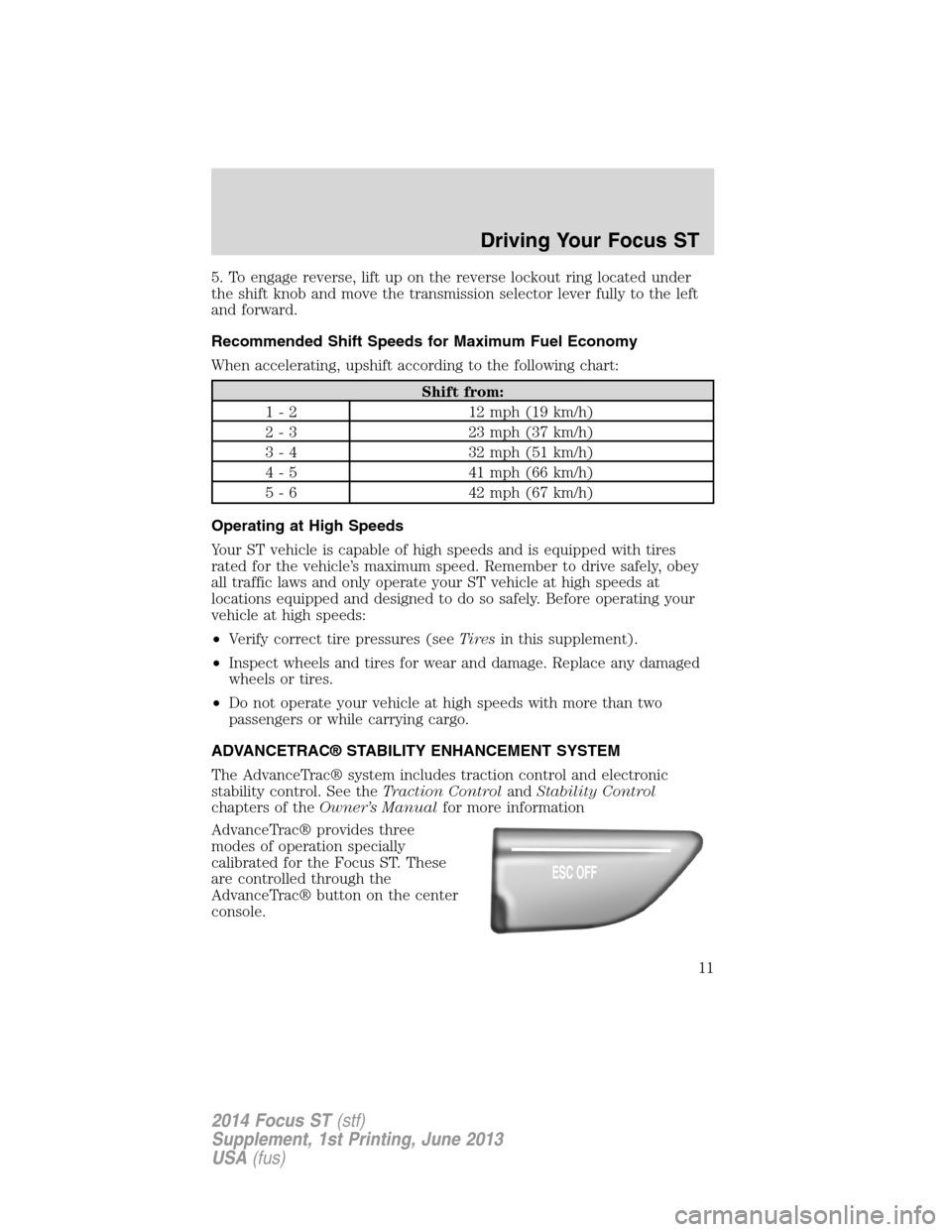
5. To engage reverse, lift up on the reverse lockout ring located under
the shift knob and move the transmission selector lever fully to the left
and forward.
Recommended Shift Speeds for Maximum Fuel Economy
When accelerating, upshift according to the following chart:
Shift from:
1 - 2 12 mph (19 km/h)
2 - 3 23 mph (37 km/h)
3 - 4 32 mph (51 km/h)
4 - 5 41 mph (66 km/h)
5 - 6 42 mph (67 km/h)
Operating at High Speeds
Your ST vehicle is capable of high speeds and is equipped with tires
rated for the vehicle’s maximum speed. Remember to drive safely, obey
all traffic laws and only operate your ST vehicle at high speeds at
locations equipped and designed to do so safely. Before operating your
vehicle at high speeds:
•Verify correct tire pressures (seeTiresin this supplement).
•Inspect wheels and tires for wear and damage. Replace any damaged
wheels or tires.
•Do not operate your vehicle at high speeds with more than two
passengers or while carrying cargo.
ADVANCETRAC® STABILITY ENHANCEMENT SYSTEM
The AdvanceTrac® system includes traction control and electronic
stability control. See theTraction ControlandStability Control
chapters of theOwner’s Manualfor more information
AdvanceTrac® provides three
modes of operation specially
calibrated for the Focus ST. These
are controlled through the
AdvanceTrac® button on the center
console.
ESC OFF
Driving Your Focus ST
11
2014 Focus ST(stf)
Supplement, 1st Printing, June 2013
USA(fus)
Page 15 of 29
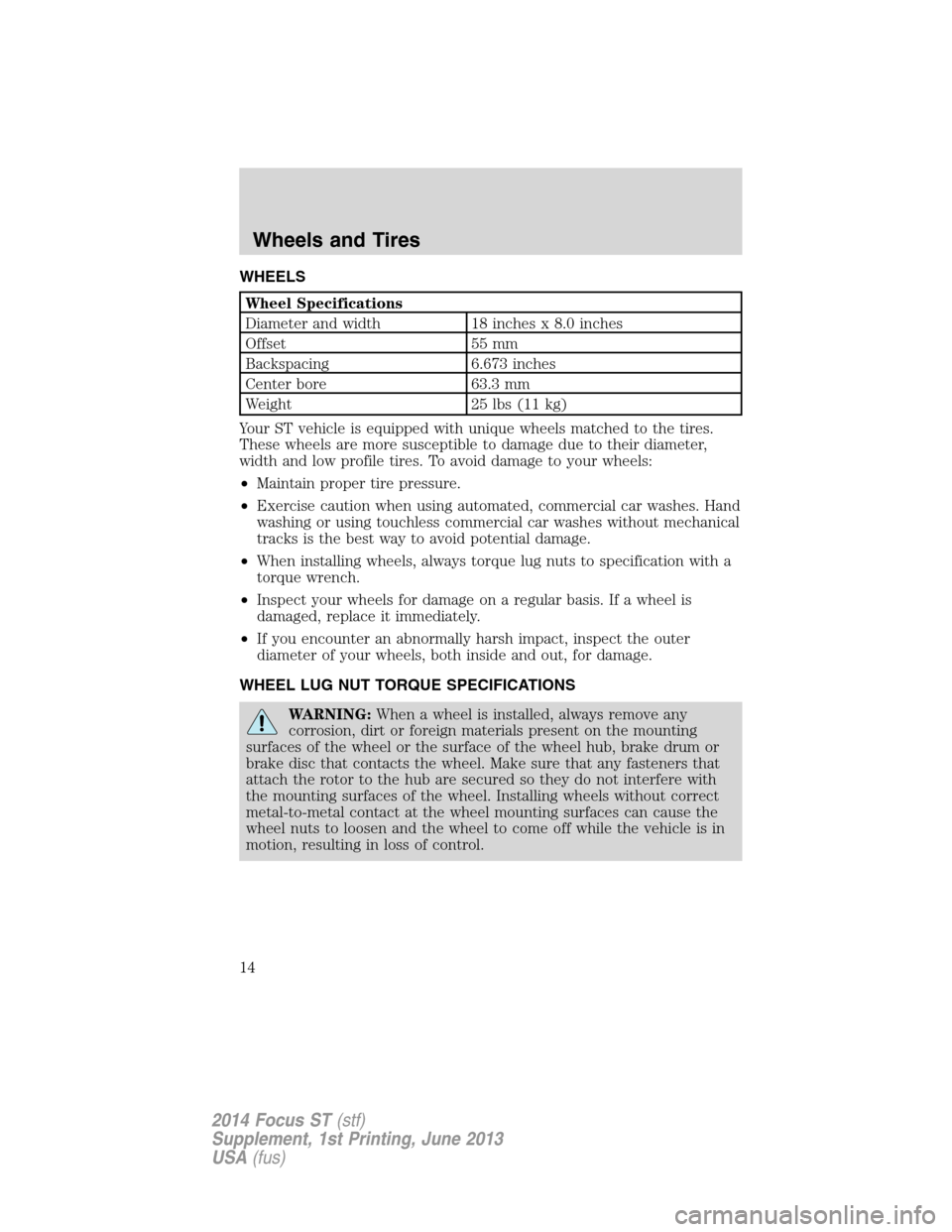
WHEELS
Wheel Specifications
Diameter and width 18 inches x 8.0 inches
Offset 55 mm
Backspacing 6.673 inches
Center bore 63.3 mm
Weight 25 lbs (11 kg)
Your ST vehicle is equipped with unique wheels matched to the tires.
These wheels are more susceptible to damage due to their diameter,
width and low profile tires. To avoid damage to your wheels:
•Maintain proper tire pressure.
•Exercise caution when using automated, commercial car washes. Hand
washing or using touchless commercial car washes without mechanical
tracks is the best way to avoid potential damage.
•When installing wheels, always torque lug nuts to specification with a
torque wrench.
•Inspect your wheels for damage on a regular basis. If a wheel is
damaged, replace it immediately.
•If you encounter an abnormally harsh impact, inspect the outer
diameter of your wheels, both inside and out, for damage.
WHEEL LUG NUT TORQUE SPECIFICATIONS
WARNING:When a wheel is installed, always remove any
corrosion, dirt or foreign materials present on the mounting
surfaces of the wheel or the surface of the wheel hub, brake drum or
brake disc that contacts the wheel. Make sure that any fasteners that
attach the rotor to the hub are secured so they do not interfere with
the mounting surfaces of the wheel. Installing wheels without correct
metal-to-metal contact at the wheel mounting surfaces can cause the
wheel nuts to loosen and the wheel to come off while the vehicle is in
motion, resulting in loss of control.
Wheels and Tires
14
2014 Focus ST(stf)
Supplement, 1st Printing, June 2013
USA(fus)
Page 16 of 29
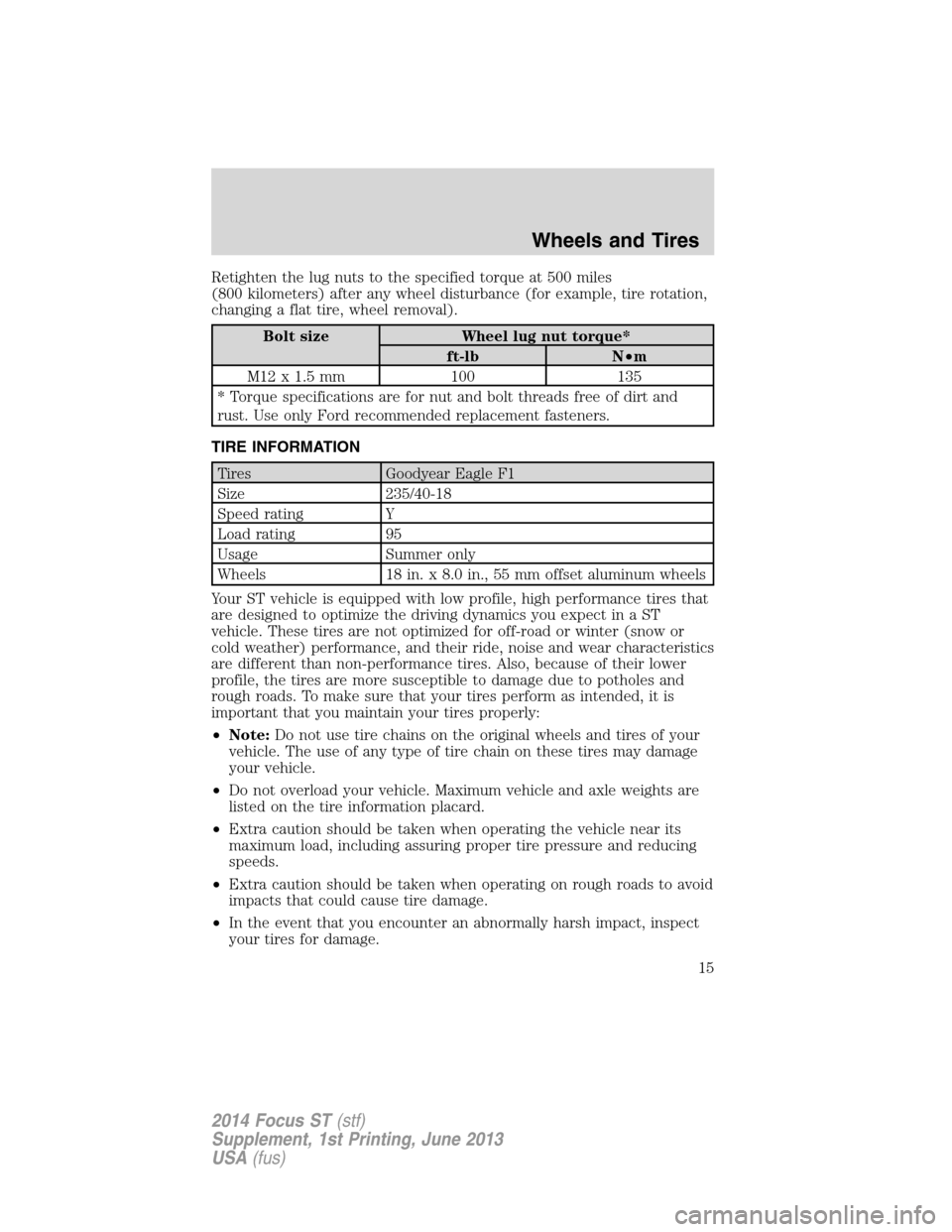
Retighten the lug nuts to the specified torque at 500 miles
(800 kilometers) after any wheel disturbance (for example, tire rotation,
changing a flat tire, wheel removal).
Bolt size Wheel lug nut torque*
ft-lb N•m
M12 x 1.5 mm 100 135
* Torque specifications are for nut and bolt threads free of dirt and
rust. Use only Ford recommended replacement fasteners.
TIRE INFORMATION
Tires Goodyear Eagle F1
Size 235/40-18
Speed rating Y
Load rating 95
Usage Summer only
Wheels 18 in. x 8.0 in., 55 mm offset aluminum wheels
Your ST vehicle is equipped with low profile, high performance tires that
are designed to optimize the driving dynamics you expect in a ST
vehicle. These tires are not optimized for off-road or winter (snow or
cold weather) performance, and their ride, noise and wear characteristics
are different than non-performance tires. Also, because of their lower
profile, the tires are more susceptible to damage due to potholes and
rough roads. To make sure that your tires perform as intended, it is
important that you maintain your tires properly:
•Note:Do not use tire chains on the original wheels and tires of your
vehicle. The use of any type of tire chain on these tires may damage
your vehicle.
•Do not overload your vehicle. Maximum vehicle and axle weights are
listed on the tire information placard.
•Extra caution should be taken when operating the vehicle near its
maximum load, including assuring proper tire pressure and reducing
speeds.
•Extra caution should be taken when operating on rough roads to avoid
impacts that could cause tire damage.
•In the event that you encounter an abnormally harsh impact, inspect
your tires for damage.
Wheels and Tires
15
2014 Focus ST(stf)
Supplement, 1st Printing, June 2013
USA(fus)
Page 17 of 29
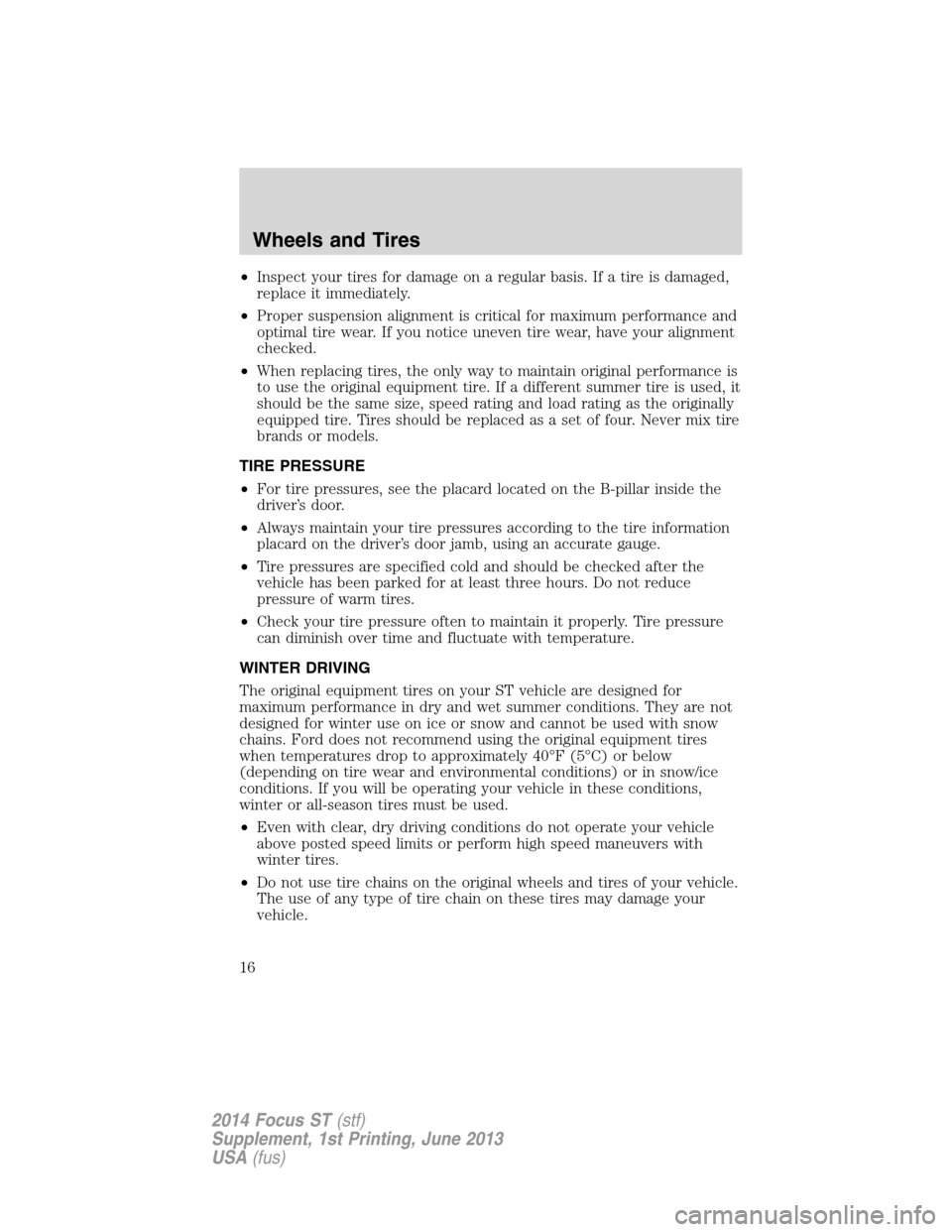
•Inspect your tires for damage on a regular basis. If a tire is damaged,
replace it immediately.
•Proper suspension alignment is critical for maximum performance and
optimal tire wear. If you notice uneven tire wear, have your alignment
checked.
•When replacing tires, the only way to maintain original performance is
to use the original equipment tire. If a different summer tire is used, it
should be the same size, speed rating and load rating as the originally
equipped tire. Tires should be replaced as a set of four. Never mix tire
brands or models.
TIRE PRESSURE
•For tire pressures, see the placard located on the B-pillar inside the
driver’s door.
•Always maintain your tire pressures according to the tire information
placard on the driver’s door jamb, using an accurate gauge.
•Tire pressures are specified cold and should be checked after the
vehicle has been parked for at least three hours. Do not reduce
pressure of warm tires.
•Check your tire pressure often to maintain it properly. Tire pressure
can diminish over time and fluctuate with temperature.
WINTER DRIVING
The original equipment tires on your ST vehicle are designed for
maximum performance in dry and wet summer conditions. They are not
designed for winter use on ice or snow and cannot be used with snow
chains. Ford does not recommend using the original equipment tires
when temperatures drop to approximately 40°F (5°C) or below
(depending on tire wear and environmental conditions) or in snow/ice
conditions. If you will be operating your vehicle in these conditions,
winter or all-season tires must be used.
•Even with clear, dry driving conditions do not operate your vehicle
above posted speed limits or perform high speed maneuvers with
winter tires.
•Do not use tire chains on the original wheels and tires of your vehicle.
The use of any type of tire chain on these tires may damage your
vehicle.
Wheels and Tires
16
2014 Focus ST(stf)
Supplement, 1st Printing, June 2013
USA(fus)
Page 25 of 29
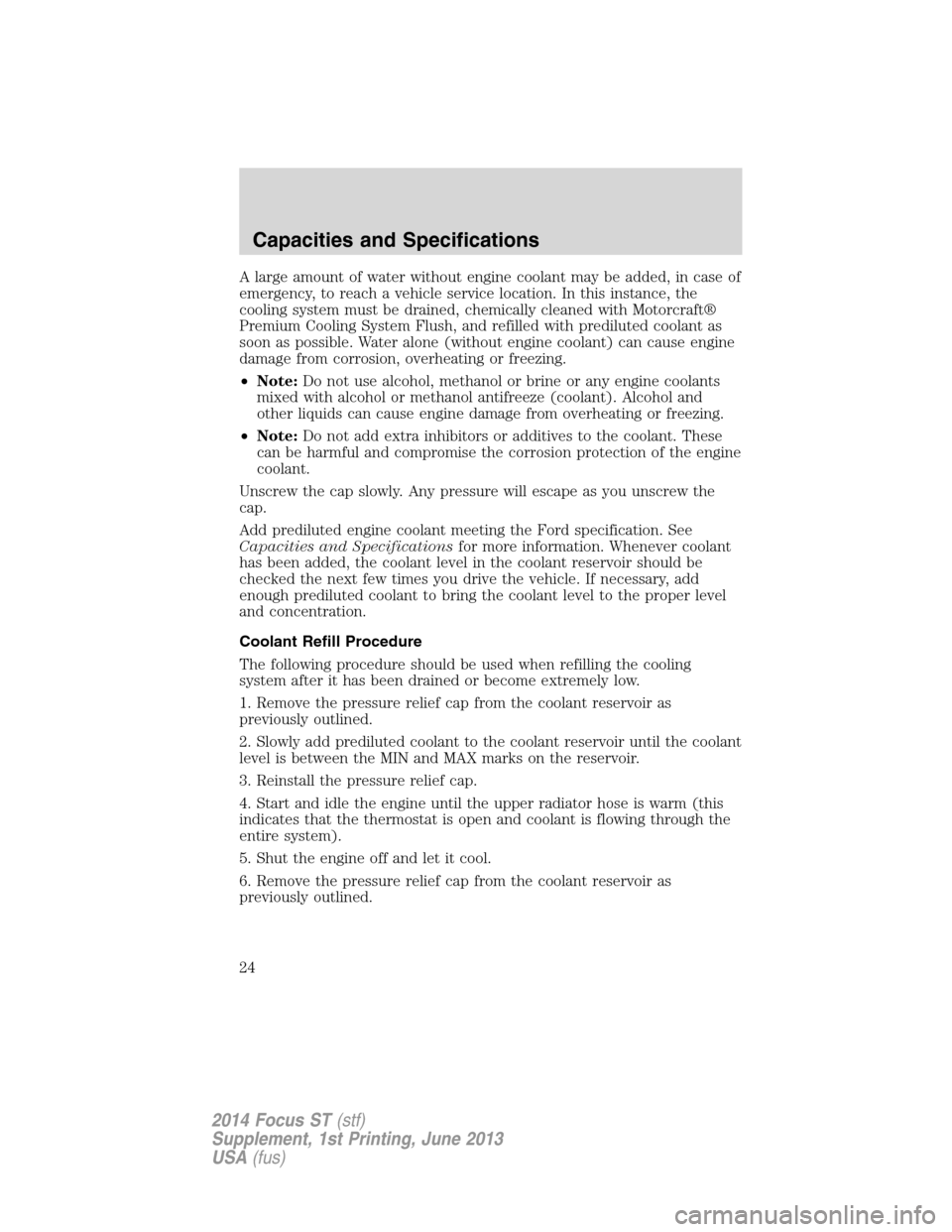
A large amount of water without engine coolant may be added, in case of
emergency, to reach a vehicle service location. In this instance, the
cooling system must be drained, chemically cleaned with Motorcraft®
Premium Cooling System Flush, and refilled with prediluted coolant as
soon as possible. Water alone (without engine coolant) can cause engine
damage from corrosion, overheating or freezing.
•Note:Do not use alcohol, methanol or brine or any engine coolants
mixed with alcohol or methanol antifreeze (coolant). Alcohol and
other liquids can cause engine damage from overheating or freezing.
•Note:Do not add extra inhibitors or additives to the coolant. These
can be harmful and compromise the corrosion protection of the engine
coolant.
Unscrew the cap slowly. Any pressure will escape as you unscrew the
cap.
Add prediluted engine coolant meeting the Ford specification. See
Capacities and Specificationsfor more information. Whenever coolant
has been added, the coolant level in the coolant reservoir should be
checked the next few times you drive the vehicle. If necessary, add
enough prediluted coolant to bring the coolant level to the proper level
and concentration.
Coolant Refill Procedure
The following procedure should be used when refilling the cooling
system after it has been drained or become extremely low.
1. Remove the pressure relief cap from the coolant reservoir as
previously outlined.
2. Slowly add prediluted coolant to the coolant reservoir until the coolant
level is between the MIN and MAX marks on the reservoir.
3. Reinstall the pressure relief cap.
4. Start and idle the engine until the upper radiator hose is warm (this
indicates that the thermostat is open and coolant is flowing through the
entire system).
5. Shut the engine off and let it cool.
6. Remove the pressure relief cap from the coolant reservoir as
previously outlined.
Capacities and Specifications
24
2014 Focus ST(stf)
Supplement, 1st Printing, June 2013
USA(fus)